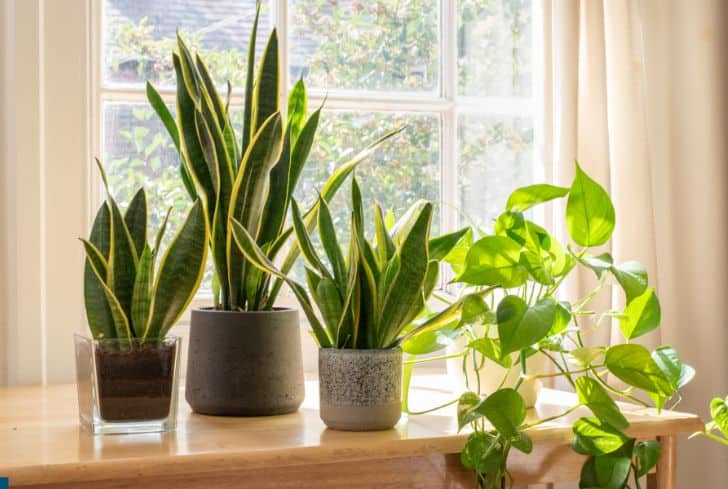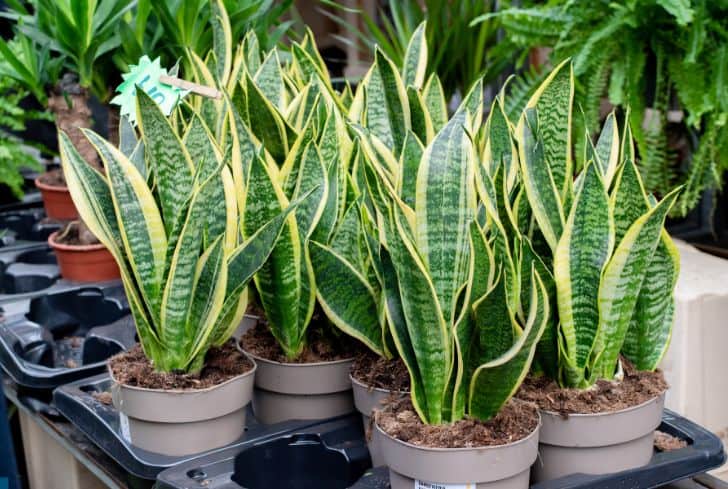The Snake plant with the scientific name Sansevieria trifasciata is a well-known houseplant that is stunning and very easy to care for. It is popular among plant lovers because of its ability to thrive even in the most unsuitable conditions. Other names commonly ascribed to snake plants include Good Luck Plant, Mother-in-Law’s Tongue, etc.
This hardy houseplant has sword-like leaves that are very stiff and broad and can get to about 2 feet in length. There are about 70 species of snake plants across the globe, and they got their name due to their long leaves and tapered end.
In this article, I will discuss extensively what will happen if your cat ingests a snake plant, how you can stop your cat from eating them, as well as the common houseplants that are toxic and safe for cats.
Are Snake Plants Poisonous to Cats?
Snake plants are very toxic to cats because they contain mildly poisonous toxins known as Saponin, which is a defensive mechanism these plants use to protect themselves from harmful fungi, insects, microbes, and other animals like cats. ASPCA also reports that all parts of snake plants are not safe for cats.
Although these plants are used for medical treatments in some parts of the world, this does not negate their poisonous nature, especially to animals like cats when ingested. It has a very numbing effect on cats, coupled with several other symptoms mentioned below. So as much as possible, please keep your cat away from this poisonous plant.
What Happens if my Cat Ingests a Snake Plant?
Your cat will experience a very bitter taste and a burning sensation once it ingests a snake plant. Due to the bitter taste of snake plants, cats are likely to ingest only a small quantity. When ingested in small amounts, snake plants aren’t harmful.
However, this plant is very poisonous to your cat when ingested in a high quantity due to the toxin present in them. But snake plant is not poisonous enough to kill your cat (if you take the necessary steps immediately to get your cat the required medical treatments). The toxins would make the cats sick for 2 to 3 days.
Some of the common symptoms you will notice if your cat ingests a snake plant include:
- Depression
- Excessive drooling
- Abdominal pain
- Loss of appetite
- Nausea
- Vomiting
- Diarrhea
- Throat and tongue swelling
Some severe symptoms your cat may experience if it already has a medical condition or if it consumed a larger quantity of the snake plant includes:
- Stomach upset
- Paralysis
- Muscle tremors
What to do if Your Cat Eats a Snake Plant?
You’ll probably notice bite marks on your plant or find plant material in your cat’s mouth if your cat has eaten parts of your snake plants. Once you observe these signs or notice your cat showing some of the symptoms we discussed earlier, the best thing to do is to take your cat to a veterinarian to assess it.
Also, take along to the veterinarian your cat’s full medical history because it will assist the veterinarian in determining and ascertaining the probable causes of the illness or further complications that may be found.
The veterinarian might ask you the types of plants that you keep at your home and if your cat is allowed to play outside, especially near those plants. As much as possible, please be honest with your answers for the well-being of your cat.
The veterinarian will also check your cat’s mouth and may induce vomiting to get the toxins out of your cat’s system. In cases of severe poisoning, medications such as Antihistamines would be administered to your cat to reduce swelling. You’ll also need to provide special care such as constant hydration to quicken the healing process.
How do I Stop my Cat From Eating my Snake Plant?
Here are a few tricks you can use to prevent your cat from eating your snake plant:
1. Take your snake plant out of the reach of the cats
The best way to stop your cat from eating your snake plant is to place it in an area that is off-limits to the cat. This is the first step you want to take to keep your cats safe.
Simply moving your snake plants to the top shelf won’t do the trick, opt for more effective options like hanging pots or a special location that is inaccessible to your cats. You can go the extra mile by creating a safe spot or cage for these curious creatures, it’ll come in really handy when you are not around to watch them.
2. Make your snake plant less appealing to the cats
You can make your snake plant smell unappetizing by surrounding it with lemon peels. Cats naturally hate the citrus smell, so it’s a very good method to keep them off. But be careful not to use concentrated citrus oils to avoid killing your snake plant.
Alternatively, you can create a cat-repellent spray by mixing cayenne pepper or vinegar with water. Make sure to reapply the spray regularly to ward off the cats. Once your cat sniffs the snake plant, it will avoid the plant as much as possible.
3. Keep the cats engaged to distract them
Oftentimes, cats use your houseplants as a plaything because they are bored, so you can keep them engaged with balls, cardboard boxes, scratching posts, or toys that appear very similar to plants. The cats would be entertained and distracted by the toys and then stay away from your snake plant.
4. Deter your cats with aluminum foil
Another way to prevent your cats from eating your plants is by covering up the soil with aluminum foil or placing the foil underneath the plant. Cats hate the texture, reflexive feature, and sound of the foil when they step on it, so they’ll be hesitant to approach the area where you’ve placed the foil.

Common Houseplants That are Most Toxic to Cats
Cats can be incredibly mischievous and are very likely to chew on things including plants. If you love your cats and wouldn’t want to go through the trouble of repelling them from your houseplants, you’ll need to avoid bringing poisonous plants into your space. Below are some of the houseplants that are most toxic to cats:
1. Sago palms
Despite having the word “palm” attached to its name, sago palms are not related to the palm family but it’s a gymnosperm closely related to the pine trees. Sago palms are one of the most common toxic houseplants to cats. They are very common in homes owing to their aesthetic features and landscaping qualities.
Some symptoms your cat would exhibit if it eats sago palms include jaundice, blood stooling, and vomiting. And these symptoms will become very noticeable within 15 minutes to 3 hrs or more after intake. Ensure you immediately give your cat the necessary treatment because the survival rate after eating these plants is above 50%.
2. Asparagus fern
Another very poisonous houseplant to cats is the Asparagus fern, also commonly known as the asparagus grass or the lace fern. Although its name depicts relation to the fern, it is not a true fern, but the asparagus fern’s leaves resemble that of the fern.
They are most times grown at home due to their appealing aesthetic floral arrangements. Some common symptoms your cat would exhibit if it eats the asparagus fern include low appetite, vomiting, diarrhea, abdominal pain, and allergic dermatitis.
3. Aloe vera
Although Aloe vera is well known for its numerous health benefits to human beings, such as treating canker sores, reduction of constipation, reduction of sugar levels in the blood, etc., and as a result, grown as houseplants, it still poses great dangers to cats because it contains the same poisonous toxin that is present in snake plants; Saponin.
Some of the symptoms your cat would exhibit after eating aloe vera include vomiting, diarrhea, nausea, etc. Ensure you keep your cat away from this toxic plant.
4 . Cyclamen
Cyclamen is another common houseplant that is very poisonous to cats. However, they are commonly used for aesthetics and beautification and they also have some health benefits with their roots and stems used as medicine.
It contains the same poisonous toxin, present in snake plants and aloe vera – Saponin. Some symptoms your cat would exhibit after eating the cyclamen plant include vomiting, drooling, diarrhea, etc.
5. Amaryllis
Another houseplant that is very toxic to cats is the Amaryllis, a member of the Liliaceae family but it differentiates itself from the ‘true lilies’ by its toxin. Almost all the parts of a typical Amaryllis plant contain to a certain degree a phenanthridine alkaloid which may cause difficulty breathing and vomiting upon intake.
As earlier mentioned, most of its parts have this poisonous toxin. Still, the most poisonous part of this plant to cats is the bulb which is always very visible in a typical Amaryllis as it contains raphide oxalate crystals which cause excessive drooling, vomiting, difficulty breathing, and oral pains.
6. Sweetheart Ivy
Sweetheart Ivy is also a very toxic houseplant to cats. It is also known as the glacier ivy or needlepoint ivy. It contains triterpenoid saponins, a poisonous toxin with symptoms like stomach and esophagus irritation, difficulty in breathing, dermatitis, excessive drooling, etc. As far as possible, ensure you keep your cat away from this toxic plant.
7. Dieffenbachia
Dieffenbachia also known as the dumb cane plant or the leopard lily, is another plant that is usually found in many households. It is a houseplant that is known to thrive well indoors.
The plant contains calcium oxalates which are very toxic to cats and is considered one of the major causes of kidney stones in humans. Some symptoms that would be exhibited after your cat eats this plant include the tongue, lips, and face swelling, ulcer, mouth blisters, excess drooling, loss of appetite, difficulty breathing, etc.
8. Ceriman
Ceriman is another very toxic houseplant to cats. It is also known as the Swiss cheese plant or hurricane plant. It is one of those well-known house plants grown for its striking appearance.
Some of the symptoms that would be exhibited if your cat eats the ceriman plant include swollen tongues, face, and lips, frequent vomiting, excessive drooling, etc.
9. Dracaena
Dracaena, also known as the corn plant, is another popular houseplant that is very harmful to cats. It contains Saponin which is the same poisonous toxin that is found in snake plants and aloe vera.
Some symptoms associated with cats that have eaten this plant include loss of appetite, excessive drooling, bloody vomiting, mental dullness, etc.
Common Houseplants That are Safe for Cats
Although some houseplants are very toxic and dangerous to your cat’s health and mental well-being, some others are safe for your cat even when ingested. Some of these safe houseplants include;
- Calathea
- African Violet
- Spider plant
- Canary date palm
- Green ripple peperomia
- Mosaic plant
- Haworthia
Final Thoughts
Snake plants are truly toxic and poisonous to your cat. So it is advisable to take your cat to the vet for a check-up and further diagnosis if you notice your cat displaying any of the symptoms we discussed earlier. As much as possible, please keep your cats away from your snake plants or opt for a houseplant that is non-toxic to cats.






